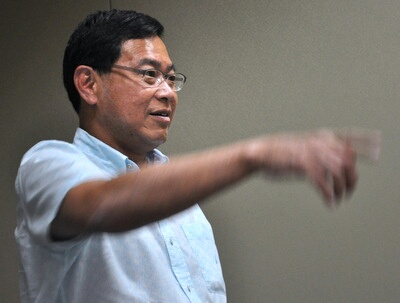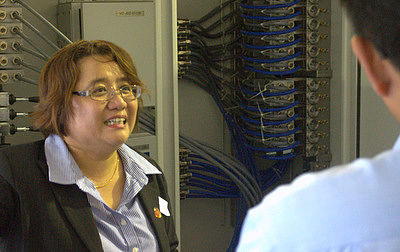 FY14 revenue is for illustrative purpose, assuming the acquisition of Austin Energy had been completed on Jan 1, 2014. Revenue for FY07-FY13 are factual.
FY14 revenue is for illustrative purpose, assuming the acquisition of Austin Energy had been completed on Jan 1, 2014. Revenue for FY07-FY13 are factual.
The above chart illustrates the steady revenue growth of Nordic Group -- and, notably, the contribution of Austin Energy had it been acquired by Nordic on 1 Jan 2014.
Austin Energy (as represented by the yellow shading in the chart) was acquired in June this year for S$26.0 million cash using a $20-m bank loan and $6 m of internal funds.
Austin Energy is, by all accounts, a steady business with strong cashflow and low capex.
Its impact on the bottomline of Nordic will be significant. Consider that Nordic Group's net profit was $7.9 million in 2014 while Austin earned $6.3 million.
For a recap of Austin Energy's business, see: NORDIC GROUP: Insights from visit to Austin Energy (recently acquired)
The business and that of its new parent, Nordic Group, were the subject of a presentation to analysts by Nordic's executive chairman Chang Yeh Hong this week. (Please see links below for our past write-ups on Nordic).
Here, we share what went on in the Q&A session:
Q: What is the level of gearing you are prepared to go up to for your next M&A? Chang Yeh Hong, executive chairman of Nordic Group. NextInsight file photo. Mr Chang:After our acquisition of Austin Energy, our gearing is about 0.7. It's low by bank-lending standards. If I were a bank, and I used to be a banker, I will lend if it's anything below 1.5.
Chang Yeh Hong, executive chairman of Nordic Group. NextInsight file photo. Mr Chang:After our acquisition of Austin Energy, our gearing is about 0.7. It's low by bank-lending standards. If I were a bank, and I used to be a banker, I will lend if it's anything below 1.5.
I have not gone to the market but if there are investors who want a share of my business, I am willing to place out new shares -- but not at the current market price (18 cents) which means the cost of capital is 20, 25%. I can go to the banks and my interest cost is only 3%.
Q: What would you look for in your future acquisitions?
Mr Chang: It must be in the same footprint of marine and oil & gas. It has to be an extension of our suite of services. I don't want to get into mechanical businesses. You know why -- they have heavy capex, risk of project cost overruns. I want a steady business which I can grow incrementally and achieve a quantum leap through M&A.
Q: Oil prices have come down sharply. Can you give us a sense of how this is going to affect your insulation and scaffolding businesses with the petrochem clients?
Mr Chang: The maintenance business is there and increasing each year. What's affected is the capex of the petrochem companies for expansion. Capex will definitely be shrunk or held back but that doesn't mean it will be held back indefinitely. Oil prices won't stay this low forever... and the companies need to expand their facilities.
There will always be projects -- the main constraint for us is manpower. We have to really improve our productivity.
Q: What's the capex of Nordic Group this year?
Mr Chang: Austin Energy -- not much. For MultiHeight Scaffolding -- we need to buy steel scaffolding for two projects for ExxonMobil and Chevron, so it's $1-2 m. If MultiHeight doesn't have major projects, its recurring capex would not be more than $500,000 a year. For our precision engineering segment, we do not intend to invest heavily in capex. For Nordic Flow, not much either.
 Dorcas Teo, executive director, Nordic Group.
Dorcas Teo, executive director, Nordic Group.
NextInsight file photo. Q: What's Nordic's shareholding like?
Mr Chang: I hold about 52%, Dorcas (the CEO) 7.6% while Eric Lin (the executive director), 11%. Together, we hold about 70%.
Q: You were a banker before. How did you become the controlling shareholder of Nordic?
Mr Chang: I started work with StanChart in 1984, and stayed on for 14 years before I was head-hunted by Citibank to be MD for Asia Pacific. Two years later, StanChart offered me a global role.
There was frequent travelling, which took a toll on me. My daughter was growing up, and didn't get to see me until weekends. I would fly off on Sunday evenings and be away for the week.
It's a cushy job with a lot of perks, such as a $2-m entertainment budget, but there was no quality of life.
At airports, I waited for my plane, on the plane I waited to land, then I went to the hotel and I waited to be picked up for the office. After office, I went to the hotel bar and talked to the bartender until it was time to sleep. And in one day, I could be flying to two countries.
The wake-up call came one day when I was walking past the Padang to a meeting. Some of my football kakis saw me and called out "Why aren't you playing football with us?"
At that time, the bank was undergoing major restructuring and it was not something I liked, so I called it quits.
With the money I had, I started investing. The first company was Technics Oil. It was my previous client, and it asked me for help.
For a 10% stake, I took them to a listing in nine months and I later cashed out. Then I invested in Nordic. I put in money, hoping to reap an easy reward.
|
I didn't expect I had to roll up my sleeves for the next seven years to transform it for a listing in 2010.
After the listing, we faced headwinds because the shipbuilding industry went into a slump. In the worst year, Dorcas and I took a 35% pay cut because I didn't want to see our company go into the red. Our pay was reinstated only last year.
I am proud that today we are on track to achieve $100 million in annual revenue -- hopefully it can grow to $200 million.
The Powerpoint materials for the analysts' briefing can be found on the SGX website.







